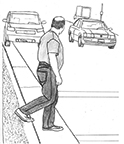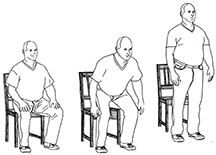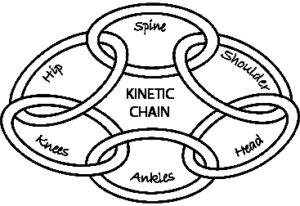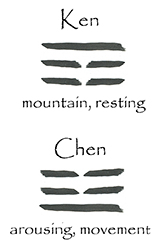 |
 |
 |
VIDEOS: Balance & Mobility | Tai Chi
Mindfulness, Balance, and Videos

Balance training and tai chi are both mindfulness practices. Mindfulness training heightens sensitivity to one’s internal state and the state of the surroundings in each moment.
If you are having difficulty controlling balance, try to eliminate distractions before starting. Focus. Be attentive to risk stress in the form of fear, anxiety, physical tension (rigidity), holding the breath, and of course instability. Be conscious of pace. Notice any consistent tendency to speed up or push limits. If drawn into the rhythm and pace of a video, be vigilant about not drifting toward control limits.
If desired, increase activity level by doing the routines more often or increasing the repetitions within a routine. Again, be mindful of pace. Pace is an expression of energy flow. The faster the pace (higher energy), the greater the demand on control mechanisms. The seeds of instability reside in the subtle judgment over whether or not one can maintain control over the demands of the moment. Slowing the pace allows more time to process sensory information, connect to our bodies, and move in ways that lower the risk of falling.
Movement patterns are exercises in problem solving. The intention to move poses a question. “Will I be able to respond and how?” The answer may be a simple and instinctive “yes” or “no” with no apparent conscious thought. The answer may be conditional, perhaps due to pain or some physical limitation. There may be a brief decision interval between impulse and action.
Mindfully guided thought and movement can smooth the management of transitions by stimulating shifts in perspective and approach. A person in a mindful state is paying closer attention to the information flowing in through the senses. This tends to improve the accuracy of judgments and the choices and actions which follow. Better choices supports a more stable cognitive, postural, and kinetic environment in our bodies.
All patterns are exercises in concentration. Everything is created twice, first in mind (information network) and then in action. When the balance and movement systems are working reliably, the close binding in time of information processing and movement creates a sense of flow and unification. This engenders a sustainable equilibrium of mental focus and skillful action.
Balance Videos
 It is especially important to sharpen our sense of risk levels when using the videos to strengthen balance. Do what feels safe. If necessary, modify movements by slowing the pace or shortening distances in order to feel secure. If a movement feels uncertain, don’t do it. Wait until you feel stronger.
It is especially important to sharpen our sense of risk levels when using the videos to strengthen balance. Do what feels safe. If necessary, modify movements by slowing the pace or shortening distances in order to feel secure. If a movement feels uncertain, don’t do it. Wait until you feel stronger.
For more information review the Guidelines for Safe Practice

The balance videos address the fundamental movement patterns that comprise daily activity. The patterns are not complex. They are the strands of movement that we know and have used all of our lives. The routines help us to sustain reliable balance by maintaining sufficient strength, flexibility, and control over movement in multiple planes of motion. This supports independence and active engagement.
Tai Chi Chuan Videos
 The tai chi chuan and the balance videos represent a snapshot of processes that are actually in a constant state of change. Videos have an inherent rigidity in that the movements they present never change. The sequences become predictable.
The tai chi chuan and the balance videos represent a snapshot of processes that are actually in a constant state of change. Videos have an inherent rigidity in that the movements they present never change. The sequences become predictable.
Since life is unpredictable, movement is often subject to unforseen deviations necessitating a spontaneous adaptive reaction. That is why group interaction and pattern variation are an important part of sustaining movement skill.
Tai chi chuan sequences are flexible structures that create an organic framework for exploring states of change and their equilibriums. They are studies in adaptation informed by exploring the relationships between resistance and flow. Consistent practice seems to drive a shift toward physical and cognitive balance.
Tai chi improves understanding of basic movement principles and teaches skillful control over the behavior of forces. It is a kinetic interaction with nature’s apparent laws such as the relationship between balance and the steady force of gravity that can manifest as falling.
Tai Chi sequences are moment to moment experiences that are uniquely colored by our surroundings and states of being. Sequences are always new and ever changing. Having no memory, they are always responsive to whatever one brings to the moment of interaction. Gradually, there is a shift toward a state of peaceful unbiased awareness and attention while practicing.
When performing any movement, first seek to discover a familiar natural relationship with it. What is the instinctive approach to the pattern? That is a beginning, like the tiny nucleus that seeds the growth of a precious gem. Such a beginning is rooted in what one feels and knows best. Tai chi clarifies and acts through that.
The videos can lead to a stronger connection to movement and the way it is expressed according to one’s unique attributes. Forget about right or wrong, good or bad, correct and incorrect. Seek the path of least resistance in each pattern. Never force a posture or movement. If there is a resistance (limit) that makes it impossible to do a movement, think about ways to adapt or compensate. In some cases it is better to postpone working with a pattern until strength and confidence have improved.
